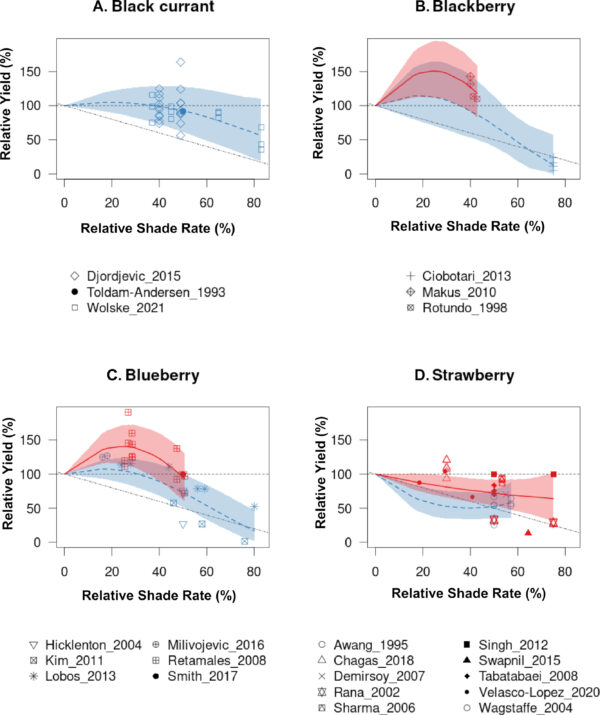A Dutch research group conducted a meta-analysis study on the tolerance of different types of berries to shade cast by agrivoltaic systems. Its work focused, in particular, on strawberries, blueberries, blackberries, and blackcurrants.
The meta-analysis consists of a statistical combination of results from multiple scientific research works focused on the same topic.
“This study provides the first yield response curves of individual berry crops to increasing shade, also distinguishing between different radiation intensity environments,” the researchers said. “The response curves provide valuable information for the design of agrivoltaics systems and can help in selecting optimal crop and panel density combinations for different locations.”
The study started with 3,677 agronomic experiments considering berry yield under at least two light levels. For their analysis, the scientists considered the whole solar radiation wavelength spectrum, the main production season of the berry, and temperatures.
“The radiation treatments are created either with shade nets, natural foliage, or a vertical light gradient in a stair-like vertical growing system,” they explained. “Radiation treatments created with enclosed impermeable covers such as plastic tunnels or glass greenhouses were excluded due to the insulation offered by these materials.”
After applying the list of criteria, 22 scientific articles remained. Out of them, the scientists created individual observations, combining the year of publication, crop variety, and relative shade rate (RSR). Through each observation, the scientists were able to define the corresponding relative yield (RY), radiation intensity level (RIlev), and shade type (ST).
“We fit a mixed effect model to account for the random differences between the publications,” the scientists explained in their approach to data analysis. “The response variable of the model was the relative yield, and we used a backwards elimination process to determine the significant fixed effects.”
Through this analysis, the academics found that the relative shade rate is a significant predictor for yield response, indicating that in most cases, low shade levels are relatively less detrimental, or even beneficial, to berry yield than high shade levels. “An exception to this is the response of strawberries with increasing yields at high shade rates,” they emphasized. “Physiologically, this response is highly improbable and can likely be attributed to the limited number of data points at low shade rates.”
Another finding was that there is a significant difference in crop yield response between environments with high and low radiation intensity. Yield losses as a result of shade, the analysis showed, are more substantial in low radiation intensity environments. “It suggests that successes of one region will not necessarily hold somewhere else,” the group said.
“We conclude that, although classified as shade-benefitting in previous literature, not all berries are equally tolerant to shade,” they added. “Whereas blueberry yield at high radiation intensities can benefit from up to 50 % shade, other berry types are better classified as shade tolerant, enduring up to 35 % shade without yield loss but declining afterwards.”
They presented their findings in the study “Berry shade tolerance for agrivoltaics systems: A meta-analysis,” published in Scientia Horticulturae. The group comprised of scientists from the Wageningen University and the Wageningen Research Foundation.

Image: Wageningen Plant Research, Scientia Horticulturae, CC BY 4.0 DEED
This content is protected by copyright and may not be reused. If you want to cooperate with us and would like to reuse some of our content, please contact: editors@pv-magazine.com.



By submitting this form you agree to pv magazine using your data for the purposes of publishing your comment.
Your personal data will only be disclosed or otherwise transmitted to third parties for the purposes of spam filtering or if this is necessary for technical maintenance of the website. Any other transfer to third parties will not take place unless this is justified on the basis of applicable data protection regulations or if pv magazine is legally obliged to do so.
You may revoke this consent at any time with effect for the future, in which case your personal data will be deleted immediately. Otherwise, your data will be deleted if pv magazine has processed your request or the purpose of data storage is fulfilled.
Further information on data privacy can be found in our Data Protection Policy.